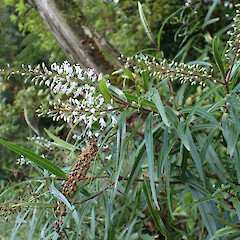Veronica angustissima
Common name
hebe
Synonyms
Veronica salicifolia var. angustissima Cockayne; Hebe angustissima (Cockayne) Bayly et Kellow,
Family
Plantaginaceae
Flora category
Vascular – Native
Endemic taxon
Yes
Endemic genus
No
Endemic family
No
Structural class
Trees & Shrubs - Dicotyledons
Chromosome number
2n = 40
Current conservation status
The conservation status of all known New Zealand vascular plant taxa at the rank of species and below were reassessed in 2017 using the New Zealand Threat Classification System (NZTCS) – more information about this can be found on the NZTCS website. This report includes a statistical summary and brief notes on changes since 2012 and replaces all previous NZTCS lists for vascular plants.
Please note, threat classifications are often suggested by authors when publications fall between NZTCS assessment periods – an interim threat classification status has not been assessed by the NZTCS panel.
- Conservation status of New Zealand indigenous vascular plants, 2017 . 2018. Peter J. de Lange, Jeremy R. Rolfe, John W. Barkla, Shannel P. Courtney, Paul D. Champion, Leon R. Perrie, Sarah M. Beadel, Kerry A. Ford, Ilse Breitwieser, Ines Schönberger, Rowan Hindmarsh-Walls, Peter B. Heenan and Kate Ladley. Department of Conservation. Source: NZTCS and licensed by DOC for reuse under the Creative Commons Attribution 4.0 International licence.
2017 | At Risk – Naturally Uncommon | Qualifiers: RR, Sp
Previous conservation statuses
2012 | At Risk – Naturally Uncommon | Qualifiers: Sp
2009 | At Risk – Naturally Uncommon
2004 | Sparse
Brief description
Low bushy shrub with long narrow pairs of leaves inhabiting riverbanks in the Opotiki and Otaki vicinities. Leaves widest towards base, to 75mm long by 9mm wide, with scattered minute hairs on margin (lens needed). Leaf bud with no gap at base. Flowers white in spikes to 11cm long
Distribution
Endemic. North Island where disjunct between Motu and Waioeka Rivers (East Cape Region) and the upper Otaki River (Tararua Range), and Takapu Stream (Tawa).
Habitat
A rheophytic shrub of riverine habitats, especially rocky gorges where it invariably grows within or just above the floodline.
Detailed description
Openly branched 1-1.4 m tall shrub of riverine banks, gorges, and cliff faces favouring sites prone to sudden flooding. Branches erect to ascending, brittle, brown to grey-brown; branchlets spindly, green, bifariously or uniformly puberulent; internodes 6-14 mm; leaf scars weakly evident. Leaf bud distinct without sinus. Leaves 22-75 x 3-9 mm, dull dark green to yellow-green, linear to linear-lanceolate, membranous, apex acute to subacute, margin puberulent. Inflorescence a lateral, unbranched raceme 47-110 mm long, bearing 29-100 flowers; peduncle 5-18 mm; rachis 41-980 mm. Bracts alternate, narrowly oblong, oblanceolate to deltoid, acute to obtuse. Flowers white or tinged mauve; pedicels 1.8-3.5 mm, longer than or equal to bracts, often recurved in fruit. Calyx 1.9-3.4 mm; lobes narrowly-oblong, lanceolate or elliptic, acute to obtuse, glabrous or hairy on the outer surface. Corolla tube 2.2-4 x 0.7-0.9 mm, white to mauve, cylindric and contracted at base, longer than calyx, internally densely hairy, externally not; lobes white or tinged mauve at anthesis, lanceolate, elliptic, obtuse or subacute, suberect to patent, equaling or longer than corolla tube. Stamen filaments 4-4.5 mm; anthers 1.4-1.8 mm, mauve or magenta. Ovary 0.6-0.9 mm, narrowly ellipsoid; style 3.5-6 mm. Capsules 2.2-3 x 1.4-2.6 mm, pale brown to brown, obtuse or subacute. Seeds 0.8-1 x 0.6-0.8 mm, straw-yellow, flattened, more or less ellipsoid to discoid.
Similar taxa
Along with Veronica rivalis this is one of the few truly rheophytic hebes. It has traditionally been included within Veronica stricta from which it differs by its habitat preference, low, spindly shrub habit, flavonoid profile, typically narrower leaves (though similar narrow-leaved forms of V. stricta occur in Northland, near Mt Pirongia and the Waitewheta Valley in the Kaimai Range but these are arborescent in habit, and are tetraploid (2n = 80) rather than diploid (2n = 40) as in V. angustissima), and narrower racemes and flowers. From the Northland endemic V. rivalis it differs by its more southerly distribution, and by its flowers whose corolla tubes exceed their calyces.
Flowering
February - June
Flower colours
Violet/Purple, White
Fruiting
March - January
Life cycle
Seeds are wind dispersed (Thorsen et al., 2009).
Propagation technique
Easily grown from semi-hardwood cuttings and fresh seed. An attractive low bushy plant that responds well to regularly pruning and trimming to keep in shape. It does well in a sunny or semi-shaded site in most soils and, in cultivation may flower throughout the year.
Threats
A biologically sparse, naturally uncommon species with a patchy and highly disjunct distribution. It does not appear to have suffered any declines but it is often very uncommon over large stretches of apparently suitable habitat, and it has yet to be found between the East Cape and southerly Tararua Ranges.
Etymology
veronica: Named after Saint Veronica, who gave Jesus her veil to wipe his brow as he carried the cross through Jerusalem, perhaps because the common name of this plant is ‘speedwell’. The name Veronica is often believed to derive from the Latin vera ‘truth’ and iconica ‘image’, but it is actually derived from the Macedonian name Berenice which means ‘bearer of victory’.
angustissima: From the Latin angustus ‘narrow, constricted’ and the superlative suffix -issumus, meaning ‘very constricted, narrow’
Where To Buy
Not commercially available
Attribution
Fact sheet prepared for NZPCN by P.J. de Lange 1 October 2006. Description based on Bayly & Kellow (2006).
References and further reading
Bayly, M.J.; Kellow, A.V. Hebes, identification, classification and biology. Wellington, Te Papa Press
Thorsen, M. J.; Dickinson, K. J. M.; Seddon, P. J. 2009. Seed dispersal systems in the New Zealand flora. Perspectives in Plant Ecology, Evolution and Systematics 11: 285-309
NZPCN Fact Sheet citation
Please cite as: de Lange, P.J. (Year at time of access): Veronica angustissima Fact Sheet (content continuously updated). New Zealand Plant Conservation Network. https://www.nzpcn.org.nz/flora/species/veronica-angustissima/ (Date website was queried)






